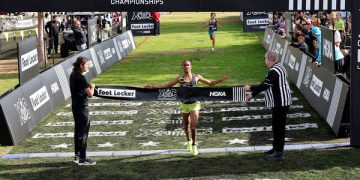 Augustine Choge, photo by PhotoRun.net
Augustine Choge, photo by PhotoRun.net
Kenya had a pretty dismal performance in Portland. In this column, our favorite Kenyan journalist, Justin Lagat, explores some of the reasons for that rough four days in Portland, Oregon.
Trying to understand why Kenya finished 25th overall at the IAAF world indoor championships in Portland yet it was 1st in Beijing.
Knowing the caliber of athletes that went out to represent Kenya in Portland, the least that was expected was four medals: Men’s 3000m had Caleb Ndiku, the defending champion, and Augustine Choge, the IAAF world indoor tour winner; women’s 3000m had Betsy Saina; women’s 800m had Margaret Nyairera and other events like the men’s 400m and 1500m had Kenyans who also advanced to the finals. But, in the end, all that Kenyans won in Portland were just two bronze medals and the country finished 25th overall.
The two medals that Kenyans won in 2014, a gold and a silver, were much better than what was won this time round. Ndiku who was expected to defend his title could only finish in 5th place.
However, this performance does not in any way indicate the strength of Kenyan athletes ahead of the Rio Olympic Games. Here, there were no 3000m steeplechase events. Neither was there a men’s Javelin throw event, nor a 400m hurdles event in which Kenyans had won their gold medals in Beijing. Kenya’s performance only served to show how different the world indoor championships are different from the outdoor championships.
But, it meant that some measures have to be taken if Kenya is to do well at the IAAF world indoor championships next time like it does in the outdoors. I could not help but ponder on some questions after seeing the results from Portland.
Should Kenya conduct indoor trials like they do with their outdoor teams?
Before the major championships, Kenyan athletes usually undergo very competitive national trials to select a strong team. This usually works in ensuring that athletes prepare and focus very well ahead of the tough national trials. Perhaps the same should be applied while choosing the team for the world indoor championships in order to pick the athletes who have prepared well to survive through the national trials.
Is the training for indoor events different from that of the outdoor events?
Perhaps with the many curves and the different environment at the indoor stadiums, then a different kind of training should be used by Kenyans interested in running in these events.
Should Kenya construct some model indoor tracks and do a number of competitions in the country in order to develop more young talents in these events?
A good excuse for Kenya’s poor performance at the world indoor championships is that there are no indoor stadiums and races in the country. Many things are learned through experience and the more the number of races that are similar to the world indoor championships are done in the country, the better the chances of Kenyans doing well in these competitions.
Author

Since 2013, Justin Lagat has written for RunBlogRun. His weekly column is called A view from Kenya. Justin writes about the world of Kenyan athletics on a weekly basis and during championships, provides us additional insights into the sport.
View all posts




















